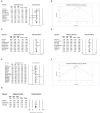Related Factors of Patent Ductus Arteriosus in Preterm Infants: A Systematic Review and Meta-Analysis
- PMID: 33469523
- PMCID: PMC7813817
- DOI: 10.3389/fped.2020.605879
Related Factors of Patent Ductus Arteriosus in Preterm Infants: A Systematic Review and Meta-Analysis
Abstract
Background: Patent ductus arteriosus (PDA) is a dramatically harmful disease in the neonatal period, in particular common in preterm infants, and our study was to determine related factors of PDA in preterm infants. Methods: A comprehensive literature review was conducted in PubMed, EMBASE, and Web of Science. The pooled odds ratio and standard mean difference were calculated to compare dichotomous and continuous variables, respectively. In addition, we also assessed the heterogeneity and publication bias and carried out sensitivity analysis for each related factor. Results: We included 45 studies with 87,419 individuals. After the primary analysis and a series of adjustments, results showed chorioamnionitis, lower gestational age, lower birth weight, bronchopulmonary dysplasia, intraventricular hemorrhage, necrotizing enterocolitis, respiratory distress syndrome, sepsis, surfactant treatment, ventilation, and lower platelet count had a positive correlation with PDA, while small for gestational age decreased the incidence of PDA in preterm infants. Besides, premature rupture of membranes, preeclampsia, antenatal steroids, male gender, mean platelet volume, and platelet distribution width were found to have no statistically significant relationship with PDA. Conclusion: Preterm infants with more immature characteristics generally have a higher likelihood to develop PDA. The prevention, diagnosis, and management of PDA may depend on these results, and effective measures can be taken accordingly.
Keywords: meta-analysis; patent ductus arteriosus; preterm infants; related factors; systematic review.
Copyright © 2021 Liu, Zhu, Li and Shi.
Conflict of interest statement
The authors declare that the research was conducted in the absence of any commercial or financial relationships that could be construed as a potential conflict of interest.
Figures








Similar articles
-
The relationship between platelet indices and patent ductus arteriosus in preterm infants: a systematic review and meta-analysis.Eur J Pediatr. 2021 Mar;180(3):699-708. doi: 10.1007/s00431-020-03802-5. Epub 2020 Sep 19. Eur J Pediatr. 2021. PMID: 32949292
-
Morbidities associated with patent ductus arteriosus in preterm infants. Nationwide cohort study.J Matern Fetal Neonatal Med. 2018 Oct;31(19):2576-2583. doi: 10.1080/14767058.2017.1347921. Epub 2017 Jul 11. J Matern Fetal Neonatal Med. 2018. PMID: 28651469
-
Ibuprofen for the treatment of patent ductus arteriosus in preterm or low birth weight (or both) infants.Cochrane Database Syst Rev. 2020 Feb 11;2(2):CD003481. doi: 10.1002/14651858.CD003481.pub8. Cochrane Database Syst Rev. 2020. PMID: 32045960 Free PMC article.
-
[Short-term outcomes and their related risk factors of extremely preterm and extremely low birth weight infants in Guangdong province].Zhonghua Er Ke Za Zhi. 2019 Dec 2;57(12):934-942. doi: 10.3760/cma.j.issn.0578-1310.2019.12.008. Zhonghua Er Ke Za Zhi. 2019. PMID: 31795560 Chinese.
-
Association of Patent Ductus Arteriosus Ligation With Death or Neurodevelopmental Impairment Among Extremely Preterm Infants.JAMA Pediatr. 2017 May 1;171(5):443-449. doi: 10.1001/jamapediatrics.2016.5143. JAMA Pediatr. 2017. PMID: 28264088 Free PMC article.
Cited by
-
Mean Platelet Volume to Platelet Distribution Width Ratio: The Most Effective Platelet Parameter in the Closer of Ductus Arteriosus.Arq Bras Cardiol. 2025 Apr;122(5):e20240635. doi: 10.36660/abc.20240635. Arq Bras Cardiol. 2025. PMID: 40366916 Free PMC article. English, Portuguese.
-
Evidence for the Management of Bronchopulmonary Dysplasia in Very Preterm Infants.Children (Basel). 2021 Apr 13;8(4):298. doi: 10.3390/children8040298. Children (Basel). 2021. PMID: 33924638 Free PMC article. Review.
-
Factors associated with discontinuation of pulmonary vasodilator therapy in children with bronchopulmonary dysplasia-associated pulmonary hypertension.J Perinatol. 2022 Sep;42(9):1246-1254. doi: 10.1038/s41372-022-01421-6. Epub 2022 Jun 8. J Perinatol. 2022. PMID: 35676536
-
Impact of antenatal corticosteroids-to-delivery interval on very preterm neonatal outcomes: a retrospective study in two tertiary centers in Japan.BMC Pregnancy Childbirth. 2024 Sep 18;24(1):607. doi: 10.1186/s12884-024-06790-8. BMC Pregnancy Childbirth. 2024. PMID: 39294574 Free PMC article.
-
Sex Differences in Patent Ductus Arteriosus Incidence and Response to Pharmacological Treatment in Preterm Infants: A Systematic Review, Meta-Analysis and Meta-Regression.J Pers Med. 2022 Jul 14;12(7):1143. doi: 10.3390/jpm12071143. J Pers Med. 2022. PMID: 35887640 Free PMC article. Review.
References
Publication types
LinkOut - more resources
Full Text Sources
Other Literature Sources

